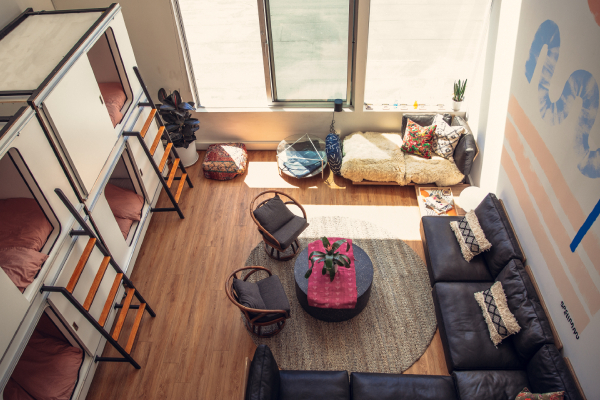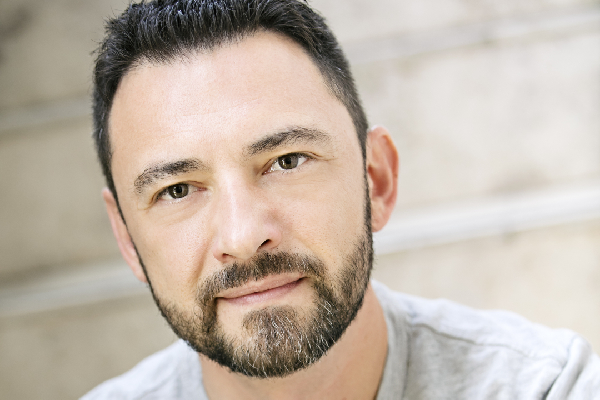Entrepreneur Steve Shpilsky views guest rooms as mostly a place to sleep – sleep as a service, as he likes to call it. So, his fledgling, California-centric brand, Stay Open, wants to bifurcate the sleep part of the hotel experience and focus more on the associated programming that he believes too many hotels don’t do well enough, including the co-work experiences for the increasing number of digital nomads. “The more places a consumer can drop into a major city, open up their phone and book a bed as easy as it is to book an Uber – that’s what we are building,” says Shpilsky, who has developed branded hotels and commercial real estate valued at over US$1 billion (1,000-plus keys), including the LAX Hyatt House/Hyatt Place. His fund also provided US$150 million in financing for the Waldorf Astoria Beverly Hills.
Shpilsky, along with co-founders Andrew Swerdloff and Alex Morrise, have big dreams of developing tens of thousands of Stay Open pods over the next five years, starting in California, by breathing life into troubled real estate such as commercial office space or tired shopping malls, and then working their way across the country from there. They are pursuing growth using US$2 million in seed funding from October 2020 that was led by a European family office. It also has a New York-based venture capital firm focused on the prop tech industry as another strategic investor. “The great thing about the prop tech firm is most of the limited partners within their funds are the very large institutional real estate players that are seeking new and innovative technologies and brands, as well as concepts to put into their spaces or services to leverage their portfolios,” Shpilsky adds.
The concept has a US$50 per night price point for a capsule and US$100-150 for a private room surrounded by co-living spaces. The pod hotel designs (a 10,000 square foot floor plate yields approximately 100 pods) will vary at each location, ranging from a one-storey commercial space in one city to a modern multi-storey property with a rooftop bar and lounge in another.
Each Stay Open hotel will include at least 10 rooms with four to eight private sleeping pods per room, and approximately 10 private rooms featuring king and queen beds for those seeking more space. Properties will feature food and beverage amenities, common areas for work or play, high-end shared restrooms, complimentary WiFi and integration with a custom app that helps match guests and residents, as well as introduce authentic local experiences.
“You don’t even have to think about where you’re going to stay or how much it’s going to cost, as you know what you’re going to get and you know the price point,” Shpilsky explains. “You’re also going to get visibility into who’s staying there. So, you can see if it’s your kind of community, if the people have similar interests, and whether you are going to make some great networking connections.”

Shpilsky believes potential guests that fit the Stay Open profile want to know what type of property they’re staying at and the makeup of its guests. “These are the new dynamics of the way people can live and work and travel. It’s all converging and plays very nicely into the product that we’re building.”
The first Stay Open opened in July as a small beta-lab near Venice Beach in Los Angeles in a Frank Gehry-designed building with just 10 pods. The space also acts as the current corporate office, and spans 3,005 square feet with 7-feet x four-feet pods, along with three Equinox gym-comparable bathrooms, as well as communal spaces that includes an open kitchen, living area and 250 square foot rooftop. Each pod contains a twin Silk & Snow bed with matching linens, USB and USB-C electrical outlets and custom LED lighting. The rooftops are used for yoga, art exhibits, local vendor sales space, performances, etc. To give the concept its social consciousness, Stay Open has created Bed-For-Bed, a nonprofit initiative that works with city officials to repurpose existing government-owned buildings to homeless housing.
Stay Open has also partnered with the Port of San Diego and California Coastal Commission to convert a former Budget Rent a Car across the street from the San Diego Airport to a US$13 million, 226-pod property to open in late 2023. Shpilsky says the leadership has also its sights set on Santa Monica, Los Angeles Santa Barbara with a general bigger focus on Southern California. “We think in a market like Los Angeles, we can easily have over 50 Stay Open properties scattered throughout the market,” Shpilsky says, adding that the concept could also work as a potential workforce housing solution in resort towns.
The San Diego project is unique and will act more as a proof of concept space as, generally, Stay Open seeks out real estate partners to own or lease the underlying real estate that Stay Open operates and markets for fees.

The concept was conceived pre-COVID, according to Shpilsky, when the group recognized retail and office space demand was on the decline. The last 18 months have served to only accelerate the phenomenon. He believes if Stay Open can “crack this nut” and take available space already by default generally in a good location from a commercial perspective… “people need a bed, whether it’s a hotel bed for a night or for a frictionless stay for a few months… There has to be a way to repurpose this space.”
Shpilsky adds that he has been financing and developing what he terms cold and boring hotels for quite some time, and among other things, it just takes way too long to get open. “It’s too expensive and a lot of times the product that’s being conceived isn’t even that great,” Shpilsky says. “Let’s try to get to a very affordable and flexible price point, but without sacrificing the experience.”
Shpilsky also points to the broader hostel segment, which he says is fragmented and not tech-forward, and creates an opportunity to acquire and/or rebrand many of these spaces down the road.
Stay Open is targeting close to an impressive 50% operating margin, as Shpilsky notes eight pods selling at US$50 a night is twice the potential ADR of a US$200 a night, same size, select-service room. “And I have eight mouths I can feed and I just put US$150 more in their pockets to spend on things they like, and maybe some of that they’re going to leave with me,” he says.
That is a recurring theme for Shpilsky: why not us? “We need to get through this inflection point of institutional ownership realizing that the days of Nordstrom showing up as your anchor tenant to take up 200,000 square feet are gone – that tenant-owner relationship dynamic is changed and probably changed for good,” he says. “Once that happens, that’ll be a key inflection point in opening up some very significant scale and good velocity for us. I think we’re probably getting close to that… Real estate needs an underlying form of cash flow, and if no one has figured out what that is then that cash flow has gone away. Someone has to figure out another operating business to put in these spaces, and we are that solution.”

